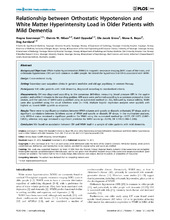| dc.contributor.author | Sønnesyn, Hogne | en_US |
| dc.contributor.author | Nilsen, Dennis W. T. | en_US |
| dc.contributor.author | Oppedal, Ketil | en_US |
| dc.contributor.author | Greve, Ole Jacob | en_US |
| dc.contributor.author | Beyer, Mona K. | en_US |
| dc.contributor.author | Aarsland, Dag | en_US |
| dc.date.accessioned | 2013-04-15T08:44:39Z | |
| dc.date.available | 2013-04-15T08:44:39Z | |
| dc.date.issued | 2012-12-19 | eng |
| dc.identifier.issn | 1932-6203 | |
| dc.identifier.uri | https://hdl.handle.net/1956/6519 | |
| dc.description.abstract | Background/Objectives: White matter hyperintensities (WMH) in magnetic resonance imaging (MRI) scans of the brain, and orthostatic hypotension (OH) are both common in older people. We tested the hypothesis that OH is associated with WMH. Design: Cross-sectional study. Setting: Secondary care outpatient clinics in geriatric medicine and old age psychiatry in western Norway. Participants: 160 older patients with mild dementia, diagnosed according to standardised criteria. Measurements: OH was diagnosed according to the consensus definition, measuring blood pressure (BP) in the supine position and within 3 minutes in the standing position. MRI scans were performed according to a common protocol at three centres, and the volumes of WMH were quantified using an automated method (n = 82), followed by manual editing. WMH were also quantified using the visual Scheltens scale (n = 139). Multiple logistic regression analyses were applied, with highest vs. lowest WMH quartile as response. Results: There were no significant correlations between WMH volumes and systolic or diastolic orthostatic BP drops, and no significant correlations between Scheltens scores of WMH and systolic or diastolic BP drops. In the multivariate analyses, only APOEε4 status remained a significant predictor for WMH using the automated method (p = 0.037, OR 0.075 (0.007–0.851)), whereas only age remained a significant predictor for WMH scores (p = 0.019, OR 1.119 (1.018–1.230)). Conclusion: We found no association between OH and WMH load in a sample of older patients with mild dementia. | en_US |
| dc.language.iso | eng | eng |
| dc.publisher | Public Library of Science | eng |
| dc.relation.ispartof | <a href="http://hdl.handle.net/1956/8578" target="blank">Frequency and prognostic implications of orthostatic hypotension and white matter hyperintensities in older people with mild dementia</a> | eng |
| dc.rights | Attribution CC BY | eng |
| dc.rights.uri | http://creativecommons.org/licenses/by/2.5/ | eng |
| dc.title | Relationship between Orthostatic Hypotension and White Matter Hyperintensity Load in Older Patients with Mild Dementia | en_US |
| dc.type | Peer reviewed | |
| dc.type | Journal article | |
| dc.description.version | publishedVersion | en_US |
| dc.rights.holder | Copyright 2012 Soennesyn et al. | |
| dc.source.articlenumber | e52196 | |
| dc.identifier.doi | https://doi.org/10.1371/journal.pone.0052196 | |
| dc.identifier.cristin | 977990 | |
| dc.source.journal | PLoS ONE | |
| dc.source.40 | 7 | |
| dc.source.14 | 12 | |

